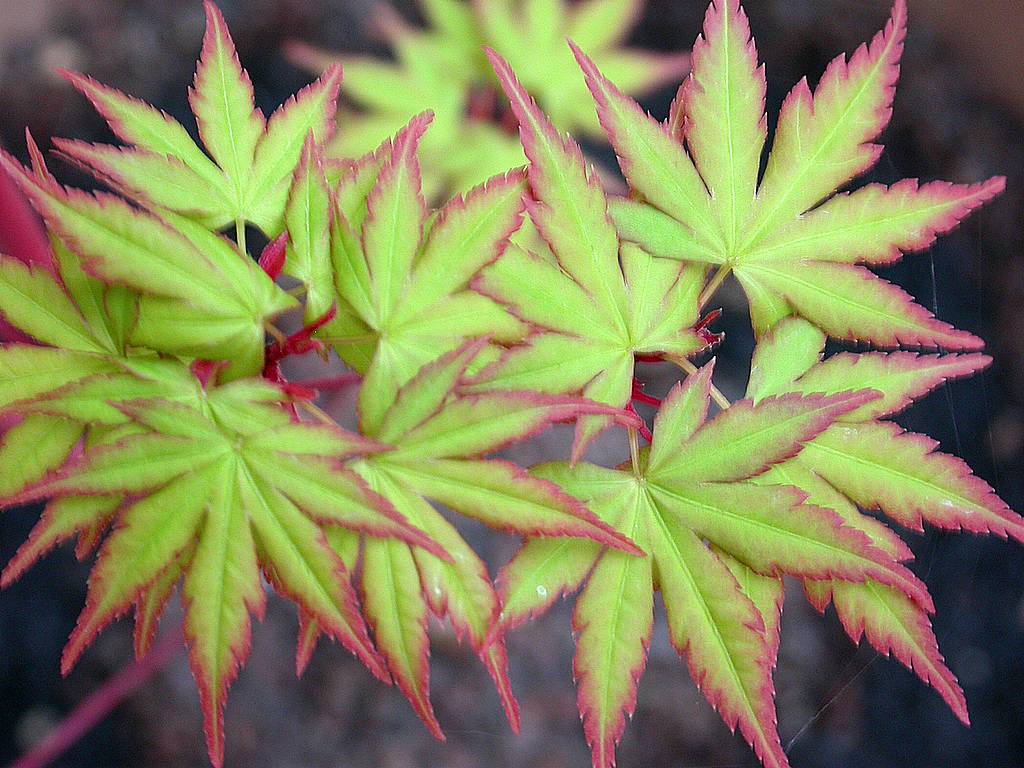|
Sapindaceae
The Sapindaceae are a family of flowering plants in the order Sapindales known as the soapberry family. It contains 138 genera and 1858 accepted species. Examples include horse chestnut, maples, ackee and lychee. The Sapindaceae occur in temperate to tropical regions, many in laurel forest habitat, throughout the world. Many are laticiferous, i.e. they contain latex, a milky sap, and many contain mildly toxic saponins with soap-like qualities in either the foliage and/or the seeds, or roots. The largest genera are '' Serjania'', ''Paullinia'', '' Allophylus'' and '' Acer''. Description Plants of this family have a variety of habits, from trees to herbaceous plants to lianas. The leaves of the tropical genera are usually spirally alternate, while those of the temperate maples ('' Acer), Aesculus'', and a few other genera are opposite. They are most often pinnately compound, but are palmately compound in ''Aesculus'', and simply palmate in ''Acer''. The petiole has a swol ... [...More Info...] [...Related Items...] OR: [Wikipedia] [Google] [Baidu] |
Sapindoideae
Sapindoideae is a subfamily of flowering plants in the soapberry family, Sapindaceae. It includes a number of fruit trees, including lychees, longans, rambutan Rambutan (; taxonomic name: ''Nephelium lappaceum'') is a medium-sized tropical tree in the family Sapindaceae. The name also refers to the edible fruit produced by this tree. The rambutan is native to Southeast Asia. It is closely related to s ...s, and quenepas. Genera Genera include: References {{Taxonbar, from=Q2224042 Rosid subfamilies Sapindaceae ... [...More Info...] [...Related Items...] OR: [Wikipedia] [Google] [Baidu] |
Maple
''Acer'' () is a genus of trees and shrubs commonly known as maples. The genus is placed in the family Sapindaceae.Stevens, P. F. (2001 onwards). Angiosperm Phylogeny Website. Version 9, June 2008 nd more or less continuously updated since http://www.mobot.org/MOBOT/research/APweb/. There are approximately 132 species, most of which are native to Asia, with a number also appearing in Europe, northern Africa, and North America. Only one species, ''Acer laurinum'', extends to the Southern Hemisphere.Gibbs, D. & Chen, Y. (2009The Red List of Maples Botanic Gardens Conservation International (BGCI) The type species of the genus is the sycamore maple, ''Acer pseudoplatanus'', the most common maple species in Europe.van Gelderen, C. J. & van Gelderen, D. M. (1999). ''Maples for Gardens: A Color Encyclopedia'' Maples usually have easily recognizable palmate leaves (''Acer negundo'' is an exception) and distinctive winged fruits. The closest relatives of the maples are the horse chest ... [...More Info...] [...Related Items...] OR: [Wikipedia] [Google] [Baidu] |
Aesculus
The genus ''Aesculus'' ( or ), with species called buckeye and horse chestnut, comprises 13–19 species of flowering plants in the family Sapindaceae. They are trees and shrubs native to the temperate Northern Hemisphere, with six species native to North America and seven to 13 species native to Eurasia. Several hybrids occur. ''Aesculus'' exhibits a classical Arcto-Tertiary distribution. Mexican buckeye seedpods resemble the ''Aesculus'' seedpods, but belong to a different genus. Carl Linnaeus named the genus ''Aesculus'' after the Roman name for an edible acorn. Common names for these trees include "buckeye" and "horse chestnut", though they are not in the same order as the true chestnuts, ''Castanea'' in the Fagales. Some are also called white chestnut or red chestnut. In Britain, they are sometimes called conker trees because of their link with the game of conkers, played with the seeds, also called conkers. Description ''Aesculus'' species have stout shoot ... [...More Info...] [...Related Items...] OR: [Wikipedia] [Google] [Baidu] |
Maple
''Acer'' () is a genus of trees and shrubs commonly known as maples. The genus is placed in the family Sapindaceae.Stevens, P. F. (2001 onwards). Angiosperm Phylogeny Website. Version 9, June 2008 nd more or less continuously updated since http://www.mobot.org/MOBOT/research/APweb/. There are approximately 132 species, most of which are native to Asia, with a number also appearing in Europe, northern Africa, and North America. Only one species, ''Acer laurinum'', extends to the Southern Hemisphere.Gibbs, D. & Chen, Y. (2009The Red List of Maples Botanic Gardens Conservation International (BGCI) The type species of the genus is the sycamore maple, ''Acer pseudoplatanus'', the most common maple species in Europe.van Gelderen, C. J. & van Gelderen, D. M. (1999). ''Maples for Gardens: A Color Encyclopedia'' Maples usually have easily recognizable palmate leaves (''Acer negundo'' is an exception) and distinctive winged fruits. The closest relatives of the maples are the horse chest ... [...More Info...] [...Related Items...] OR: [Wikipedia] [Google] [Baidu] |
Hippocastanoideae
Hippocastanoideae is a subfamily of flowering plants in the soapberry family Sapindaceae. The group was formerly treated as the separate families Aceraceae and Hippocastanaceae. Molecular phylogenetic research by Harrington et al. (2005) has shown that while both the Aceraceae and Hippocastanaceae are monophyletic in themselves, their removal from the Sapindaceae ''sensu lato'' would leave Sapindaceae ''sensu stricto'' as a paraphyletic group, particularly with reference to the genus ''Xanthoceras''. The most widespread genera are '' Acer'' (the maples) and ''Aesculus The genus ''Aesculus'' ( or ), with species called buckeye and horse chestnut, comprises 13–19 species of flowering plants in the family Sapindaceae. They are trees and shrubs native to the temperate Northern Hemisphere, with six spe ...'' (the horse chestnuts and buckeyes). A feature of the subfamily is the palmate compound leaves. [...More Info...] [...Related Items...] OR: [Wikipedia] [Google] [Baidu] |
Xanthoceroideae
''Xanthoceras sorbifolium'', the yellowhorn, shiny leaf yellowhorn, goldenhorn, or Chinese flowering chestnut, is a woody oil tree species in the family Sapindaceae, and the only species in the genus ''Xanthoceras''. It is native to northern China in the provinces of Gansu, Hebei, Henan, Liaoning, Nei Monggol, Ningxia, Shaanxi, and Shandong. It is also cultivated in Russia, having been imported there since the 19th Century. The genus name ''Xanthoceras'' (which translates as "yellow horn") is considered to be the most basal member of the family Sapindaceae.Harrington, M. G., Edwards, K. J., Johnson, S. A., Mark W. Chase, M. W., & Gadek, P. A. (2005). Phylogenetic inference in Sapindaceae ''sensu lato'' using plastid ''mat''K and ''rbc''L DNA sequences. ''Systematic Botany'' 30 (2): 366-382Abstract./ref> The specific epithet ''sorbifolium'' refers to the leaves, which resemble those of the distantly related rowans (''Sorbus''). It was originally spelled ''sorbifolia'', but ... [...More Info...] [...Related Items...] OR: [Wikipedia] [Google] [Baidu] |
Litchi Chinensis
Lychee (US: ; UK: ; ''Litchi chinensis''; ) is a monotypic taxon and the sole member in the genus ''Litchi'' in the soapberry family, ''Sapindaceae''. It is a tropical tree native to Southeast and Southwest China (the Guangdong, Fujian, Yunnan and Hainan provinces), Assam, Vietnam, Laos, Myanmar, Thailand, Malaya, Jawa, Borneo, Philippines and New Guinea. The tree is introduced into Cambodia, Andaman Islands, Bangladesh, East Himalaya, India, Mauritius and Réunion. The cultivation in China is documented from the 11th century. China is the main producer of lychees, followed by Vietnam, India, other countries in Southeast Asia, the Indian Subcontinent, Madagascar and South Africa. A tall evergreen tree, the lychee bears small fleshy fruits. The outside of the fruit is pink-red, roughly textured, and inedible, covering sweet flesh eaten in many different dessert dishes. Lychee seeds contain methylene cyclopropyl glycine which can cause hypoglycemia associated with outbreaks ... [...More Info...] [...Related Items...] OR: [Wikipedia] [Google] [Baidu] |
Dodonaeoideae
Dodonaeoideae is a subfamily of flowering plants in the soapberry family, Sapindaceae. Genera Genera recognized by the Angiosperm Phylogeny Website. *'' Arfeuillea'' Pierre ex Radlk. *'' Averrhoidium'' Baill. *'' Cossinia'' Comm. ex Lam. *'' Diplokeleba'' N.E.Br. *'' Diplopeltis'' Endl. *'' Distichostemon'' F. Mueller *'' Dodonaea'' Mill. *'' Doratoxylon'' Thouars ex Benth. & Hook.f. *†'' Euchorium'' Ekman & Radlk. *'' Euphorianthus'' Radlk. *'' Eurycorymbus'' Hand.-Mazz. *'' Exothea'' Macfad. *'' Filicium'' Thwaites *'' Ganophyllum'' Blume *''Harpullia'' Roxb. *'' Hippobromus'' Eckl. & Zeyh. *'' Hypelate'' P.Browne *'' Llagunoa'' Ruiz & Pav. *'' Loxodiscus'' Hook.f. *'' Magonia'' A.St.-Hil. *''Majidea ''Majidea'' is a genus of flowering plants belonging to the family Sapindaceae. Its native range is Tropical Africa and Madagascar. It is found in the countries of Angola, Benin, Cameroon, Central African Republic, Congo, Gabon, Ghana, Ivory Coas ...'' Kirk ex Oliv. *'' Zanha ... [...More Info...] [...Related Items...] OR: [Wikipedia] [Google] [Baidu] |
Sapindales
Sapindales is an order of flowering plants. Well-known members of Sapindales include citrus; maples, horse-chestnuts, lychees and rambutans; mangos and cashews; frankincense and myrrh; mahogany and neem. The APG III system of 2009 includes it in the clade malvids (in rosids, in eudicots) with the following nine families: *Anacardiaceae * Biebersteiniaceae *Burseraceae * Kirkiaceae *Meliaceae * Nitrariaceae (including Peganaceae and Tetradiclidaceae) *Rutaceae *Sapindaceae * Simaroubaceae The APG II system of 2003 allowed the optional segregation of families now included in the Nitrariaceae. In the classification system of Dahlgren the Rutaceae were placed in the order Rutales, in the superorder Rutiflorae (also called Rutanae). The Cronquist system of 1981 used a somewhat different circumscription, including the following families: * Staphyleaceae * Melianthaceae *Bretschneideraceae * Akaniaceae *Sapindaceae * Hippocastanaceae * Aceraceae *Burseraceae *Anacardiaceae *Jul ... [...More Info...] [...Related Items...] OR: [Wikipedia] [Google] [Baidu] |
Ackee
The ackee, also known as ankye, achee, akee, ackee apple or ayee (''Blighia sapida'') is a fruit of the Sapindaceae ( soapberry) family, as are the lychee and the longan. It is native to tropical West Africa. The scientific name honours Captain William Bligh who took the fruit from Jamaica to the Royal Botanic Gardens in Kew, England, in 1793. The English common name is derived from the West African Akan ''akye fufo''. Although having a long-held reputation as being poisonous with potential fatalities, the fruit arils are renowned as delicious when ripe, prepared properly and cooked and are a feature of various Caribbean cuisines. Ackee is the national fruit of Jamaica and is considered a delicacy. Botany Ackee is an evergreen tree that grows about 10 metres tall, with a short trunk and a dense crown. The leaves are paripinnately, compound long, with 6–10 elliptical to oblong leathery leaflets. Each leaflet is long and wide. The inflorescences are fragrant ... [...More Info...] [...Related Items...] OR: [Wikipedia] [Google] [Baidu] |
Lychee
Lychee (US: ; UK: ; ''Litchi chinensis''; ) is a monotypic taxon and the sole member in the genus ''Litchi'' in the soapberry family, ''Sapindaceae''. It is a tropical tree native to Southeast and Southwest China (the Guangdong, Fujian, Yunnan and Hainan provinces), Assam, Vietnam, Laos, Myanmar, Thailand, Malaya, Jawa, Borneo, Philippines and New Guinea. The tree is introduced into Cambodia, Andaman Islands, Bangladesh, East Himalaya, India, Mauritius and Réunion. The cultivation in China is documented from the 11th century. China is the main producer of lychees, followed by Vietnam, India, other countries in Southeast Asia, the Indian Subcontinent, Madagascar and South Africa. A tall evergreen tree, the lychee bears small fleshy fruits. The outside of the fruit is pink-red, roughly textured, and inedible, covering sweet flesh eaten in many different dessert dishes. Lychee seeds contain methylene cyclopropyl glycine which can cause hypoglycemia associated with outbreaks ... [...More Info...] [...Related Items...] OR: [Wikipedia] [Google] [Baidu] |
Allophylus
''Allophylus'' is a genus within the plant family Sapindaceae. A list of species (incomplete): * '' Allophylus agbala'' Hauman * '' Allophylus aldabricus'' Radlk. * '' Allophylus bullatus'' Radlk. * '' Allophylus chartaceus '' (Kurz) Radlkofer * '' Allophylus chirindensis'' Baker f. * ''Allophylus cobbe'' (L.) Rausch. * '' Allophylus decipiens'' (E.Mey.) Radlk. * '' Allophylus dodsonii'' A.H.Gentry * '' Allophylus edulis'' (St.Hil.) Radlk. * '' Allophylus hispidus'' (Thwaites) Trimen * '' Allophylus marquesensis'' F. Brown * '' Allophylus natalensis'' (Sond.) De Winter * '' Allophylus pachyphyllus'' Radlk. Ludwig Adolph Timotheus Radlkofer (19 December 1829, in Munich – 16 February 1927, in Munich), was a Bavarian taxonomist and botanist. Radlkofer became a physician in 1854 and earned a PhD in botany at Jena the following year. He became an ass ... * '' Allophylus rapensis'' F. Brown * '' Allophylus rhoidiphyllus'' Balf. f. * '' Allophylus rhomboidalis'' (Nadeaud) Radlkof ... [...More Info...] [...Related Items...] OR: [Wikipedia] [Google] [Baidu] |
_W2_IMG_1899.jpg)







